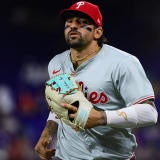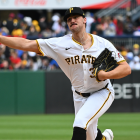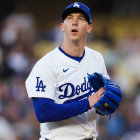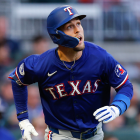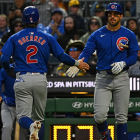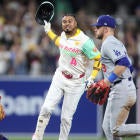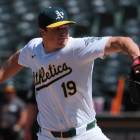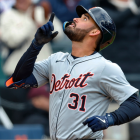Dodgers rookie first baseman/left fielder Cody Bellinger entered Friday night's game against the Padres (LAD 8, SD 2) with a slash line of .303/.361/.576 through the first nine games of his big-league career. Needless to say, that's excellent production.
Then against the Pads, the 21-year-old did this ...
Yep, that's a pair of home runs (with Mom in the stands). Now Bellinger is hitting .342/.390/.737 through his first 41 plate appearances. Obviously, the sample size is small, but already we're seeing some trends that may have some "stickiness" as Bellinger gets deeper into his career.
Mostly, that has to do with quality of contact off the bat. Thus far in 2017, the ball is leaving Bellinger's bat at an average of 91.01 mph versus a league-average exit velocity of 87.72. He's also got an average launch angle of 20.07 degrees, which means he's swinging up on the ball and finding the sweet spot where elevated line drives and well-struck fly balls live. Here's more, via FanGraphs ...
% of soft-hit balls | % of medium-hit balls | % of hard-hit balls | |
Cody Bellinger | 13.3% | 40.0% | 46.7% |
2017 MLB average | 19.1% | 49.4% | 31.5% |
Basically, Bellinger, relative to league standards in 2017, has traded a lot weak and mid-grade contact for hard contact -- the kind of contact that does damage when, like Bellinger, you're hitting the ball in the air almost half the time. Framed another way, if Bellinger had a qualifying number of plate appearances, then his hard-hit percentage would rank 17th in all of baseball this season. That's impressive for any hitter, let alone a 21-year-old sampling pitching at the highest level for the first time. Those are also things -- quality of contact, fly-ball tendencies, launch angle -- that tend to stabilize pretty early.
In related matters, Bellinger has long been a highly-regarded prospect. The former fourth-rounder (2013) and son of ex-big-leaguer Clay Bellinger owns a minor-league line of .271/.353/.501 in 361 games. He also crafted that line against a peer group that was significantly older at every stop. Coming into the 2017 season, MLB.com's Jonathan Mayo tabbed Bellinger as the No. 10 overall prospect in baseball. So the early results and skill patterns are backed up by his minor-league dossier and scouting profile. That is to say, he's not coming from nowhere.
So we know Bellinger's good and has a sustainable foundation. More to the point for the Dodgers, he's just what they need. Bellinger's primarily a first baseman, and right now the Dodgers' stalwart first-sacker, Adrian Gonzalez, is on the disabled list with forearm tendinitis. As Bill Shaikin of the Los Angeles Times notes, Gonzalez has also been dealing with a herniated disk in his back. It's not certain how long he'll be out, but as long as he is, Bellinger has a clear path to regular playing time.
Even assuming Gonzalez fully recuperates, it's fair to ask how much the Dodgers can expect from him going forward. A-Gon has had an excellent career, but he turns 35 on Monday. He also showed significant signs of decline last season, when he put up his worst OPS+ since his rookie season of 2005 and also saw a spike in his strikeout rate. As well, he's continued to leak value with the glove.
It's fair to ask how much even a reasonably healthy Gonzalez can offer a contender in 2017 and beyond. He's under contract through 2018, and given the justifiable pride he takes in his craft it seems unlikely he'll quietly accept a secondary role. Such a scenario could challenge the skills that Dave Roberts has developed when it comes to keeping all those veteran outfielders at least outwardly happy.
Speaking of which, Bellinger can also play the outfield. If Gonzalez returns and improves at the plate or his regular presence in the lineup is otherwise deemed worthwhile, then Bellinger can perhaps fill another role. In the minors, he spent almost 500 defensive innings in the outfield spread across all three positions. The healthy majority of those innings came in center, so he's not a lumbering first baseman faking it out there. That flexibility could prove useful if Yasiel Puig continues his inconsistent production or if Andrew Toles gets exposed -- reasonable possibilities, both. As for that bygone outfield glut noted above, it's worth noting that the Dodgers have no idea when Andre Ethier will be healthy. As well, Scott Van Slyke and Trayce Thompson have played their way back to Triple-A.
All of this is to say that Bellinger, even upon the return of Gonzalez, should be able to be a regular in the lineup. The Dodgers, who presently rank a disappointing 10th in the NL in OPS, can certainly use him. The skills are there for Bellinger to continue producing at a high level, and an another impact bat penciled in every day is exactly what the Dodgers need. This team has legitimate designs on the World Series, and Bellinger as a fixture makes it more likely they'll get there.










